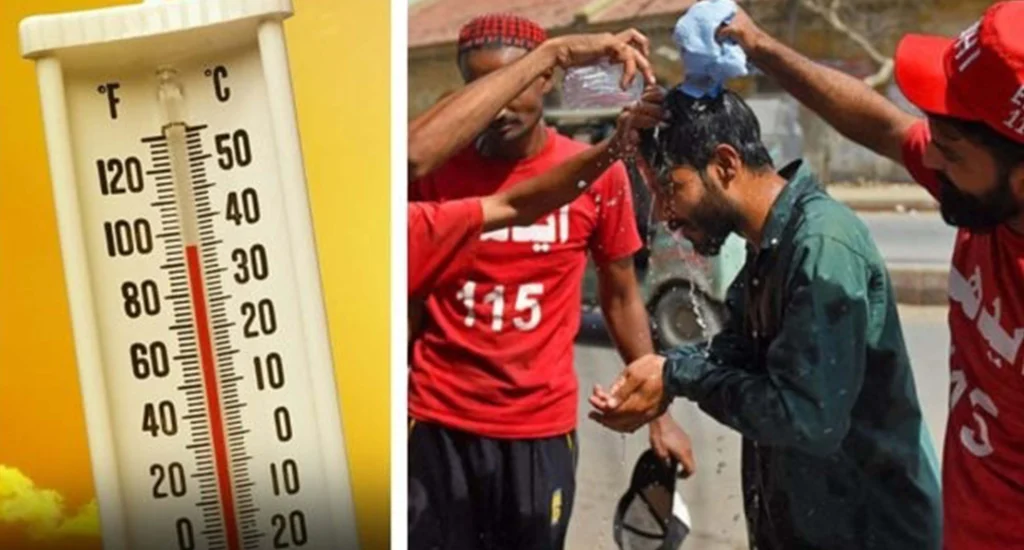Heatwave in Pakistan: Clothing Tips, Safety Measures & Urgent Climate Warnings
- Abeera Marium Siddiqui
- April 15, 2025
- 3:22 pm
- 50
- Trending

The heatwave in Pakistan continues to intensify as temperatures rise far above normal levels. The Pakistan Meteorological Department (PMD) has warned that much of the country will face scorching conditions until at least April 18. Southern Punjab, Sindh, and Balochistan will see daytime highs between 46°C and 48°C. Cities like Dadu, Nawabshah, and Sukkur are among the worst hit.
Karachi faces hot and humid weather with temperatures around 36°C. Central Punjab cities, including Multan, Sargodha, and D.G. Khan, are expected to hover around 40°C. Lahore may reach 37°C, while Islamabad and the northern regions could see temperatures rise 4°C to 6°C above average.
Dress Smart to Beat the Heat
Doctors and health experts stress the importance of heat-conscious clothing. What you wear can protect you from heat stress.
For men, loose-fitting cotton shirts in light colors like white, beige, or pastel shades are best. These colors reflect sunlight and keep the body cool. Linen trousers or lightweight chinos also help. Avoid denim or dark fabrics as they trap heat and block airflow.
Women should wear traditional lawn fabric. This lightweight cotton is popular in Pakistan for good reason. Flowing dresses, palazzos, and airy tops in breathable materials allow better ventilation. Cotton scarves or chiffon dupattas offer extra sun protection without making you feel warmer.
Children need special care during heatwaves. Dress them in soft cotton with tight weaves to block UV rays. Long-sleeved shirts and loose pants protect better than shorts. Wide-brimmed hats shield the face, ears, and neck from sunburn. At night, use light pyjamas or just a nappy, and avoid heavy bedding.
Stay Safe During Extreme Weather
PMD and health authorities advise everyone to take serious precautions during this extreme weather period.
- Drink plenty of water, even if you don’t feel thirsty.
- Avoid outdoor activity between 11 a.m. and 3 p.m.
- Use sunscreen, wear sunglasses, and stay in the shade or indoors.
- Take cool showers or place wet towels on your neck and wrists.
- Check on children, the elderly, and those with health conditions.
- Use fans, cooling cloths, or misting devices to reduce body temperature.
Karachi’s residents, already familiar with heatwaves, are being urged to stay informed. Monitoring weather reports and acting early can help reduce risk.
Wider Climate Concerns and Agriculture Impact
The heatwave in Pakistan highlights deeper climate issues. A high-pressure system over the upper atmosphere is pushing temperatures higher across the country. Dust storms and windstorms are expected due to extreme heating. These could damage electric poles, solar panels, and weak structures.
Northern regions face an additional challenge—rapid snowmelt. Rising temperatures can lead to faster melting in glaciers, increasing the risk of water-related emergencies.
The situation is even more alarming for farmers. Pakistan’s major agricultural zones are already struggling with drought-like conditions. The shortage of rain in early 2025 has left dams like Tarbela and Mangla at low levels. Now, extreme heat could harm crops and livestock.
PMD has urged farmers to adjust schedules, protect animals, and conserve water. However, experts believe more must be done. Pakistan needs long-term plans to help farmers adapt to climate change. Traditional farming methods may no longer work. Training programs and modern practices are urgently required.
Climate scientists also warn about water waste. Pakistan must act quickly to conserve water and protect its natural resources. Without serious measures, the country could face even worse environmental disasters in the near future.



